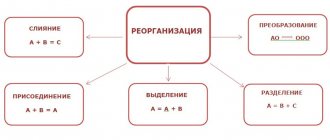Why conduct an employee job satisfaction survey?
The natural desire of every owner is to get the best possible result from their business.
Funds are invested in equipment, modern technologies and materials, but very often the expected effect does not occur. To improve efficiency, consultants, analysts, and trainers are brought in, but there is no result. In most cases, the reason for failures lies in people - in the company's employees, or more precisely, in their attitude to tasks and to the company itself. And if with employees occupying top positions everything is more or less transparent - they are visible, their tasks are digitized and controlled, then with the rest of the staff - workers, engineers, office staff - everything is much more complicated. Especially in large companies, where the ideas of the owner are distorted on the way to the performers, and the aspirations and needs of ordinary workers and specialists simply do not reach the top level, getting stuck in the labyrinths of information channels of middle management.
There are two magical concepts that can give an employer confidence that the tasks facing a business will be more or less completed. These are satisfaction and engagement. Why are these two criteria important?
Engagement is the willingness of employees to do more than is expected of them, to invest in the company’s results as in their own personal results.
Satisfaction is an employee’s emotional response to the conditions in which he works.
Satisfied employees are more likely to relax at some point. Everything is fine with them, they don’t want to change anything, any attempt to shake their status quo is met with hostility. Therefore, it is important to monitor both employee satisfaction and engagement levels.
Contents of the application form when applying for a job
There is no single sample application form for employment. Managers themselves decide which aspects of applicants’ lives interest them. An approximate list of requested information may be as follows:
- personal data of the candidate (full name, place of residence, citizenship);
- availability of education;
- existing professional skills, work experience;
- information about previous work activities;
- sources of income, desired salary level;
- Foreign language skills;
- marital status, family composition;
- having a criminal record;
- hobbies, hobbies;
- other questions.
Most of the information in the application form when applying for a job duplicates the resume of a potential employee, but it also contains information about the employee’s personal preferences, his habits and lifestyle. All this helps to create a more complete portrait of the future employee as a specialist and as an individual.
To learn about what data needs to be reflected in an employee’s personal card and what to do when changing it, read the material “How to correctly make changes to a personal card?” .
EXPLANATIONS from ConsultantPlus: By order of foreign founders, when hiring new employees, applicants' questionnaires must be sent to the founders in France, after reviewing the questionnaires, the founders make either a positive or negative decision on hiring. Is it possible to transfer personal data of Russian citizens outside the territory of the Russian Federation? Read the answer from K+ experts at the link. If you do not have access to the K+ system, get a trial online access for free.
Factors influencing job satisfaction
Since staff satisfaction is a reaction to working conditions, it is necessary to take into account the entire range of factors that directly or indirectly affect the employee. Every company is unique, but I believe there are job satisfaction factors that no company should ignore:
- Economic factor - includes everything related to remuneration: the level of wages, the regularity and timeliness of its payment, the presence of indexation and all additional payments required by law.
- Social factor - the presence, composition, size, conditionality and accessibility of a social package.
- Physical factor - here they take into account the convenience of the workplace, its equipment and compliance with labor protection requirements, the provision of high-quality and convenient tools, means of individual and collective protection from the effects of harmful factors.
- The communicative factor determines the microclimate in the team, the level of professional training of colleagues, and interaction with colleagues.
- Leadership style - this factor includes communication with management, methods of setting tasks, the level of delegation and trust, the presence of management’s interest in specific employees, management’s execution of agreements.
- Discipline - takes into account the accuracy of following the rules and requirements established in the company, the attitude towards the assigned tasks and the quality of the work performed by both the employees themselves and their colleagues.
- Career and development - having the opportunity to learn, grow professionally, and climb the career ladder.
- Loyalty is the willingness of employees to work in the company for a long time, to recommend the company to friends, employees’ awareness of the need for themselves and their work.
- Awareness - sufficiency and timeliness of information about the enterprise and events, reliability of information, possibility of feedback.
Staff Satisfaction Questionnaire: Sample
The following sample can be used as a basis for drawing up a questionnaire at a specific enterprise.
Each employee must independently fill out the questionnaire within the specified time and return it for calculation of the results. If possible, research should be conducted anonymously, as this significantly increases the chances of obtaining reliable results.
Management can use the data obtained during the survey to improve working conditions for staff. As a result of such a survey, it is possible not only to clarify weaknesses in communications, but also to identify other factors that interfere with coordinated work in the company.
In conclusion, it must be added that it is important for employees to see that their participation in the survey was not a formality, but had an impact on the work of the company. Management should really try to solve the identified problems and take appropriate steps to do so.
Large enterprises in the West, and more recently in Russia, are increasingly beginning to use employee surveys in order to find out the opinion of the company not only from external audiences, but also from internal ones. Using a survey, you can determine what the company’s employees think about its activities, future, and image. Also, thanks to the survey, it is possible to find out whether people working in the organization are satisfied with their salary, social package, relationship with management and the team.
An important point of the study based on a questionnaire on personnel management is this: operators should be able to easily find a common language and establish contact with respondents during the conversation.
In general, the purpose of the employee survey is to study the personnel management system that exists at the enterprise and the opinions of employees.
How to increase employee loyalty without increasing salaries
Often, employers treat their employees as cogs without valuing them. For what? After all, there are no irreplaceable workers! If these quit, we will find others. In pre-crisis times, the limiting factor for showing such an attitude towards employees was the need to train a new employee, which increased financial and time costs. And now it is more difficult for workers to change jobs and many employers are taking advantage of the difficult economic situation to justify reductions or reductions in payments, lack of indexation and other cost-cutting measures (which, by the way, are often violations of labor laws).
Continue reading in ConsultantPlus
How to compose correctly
Before you create a job application , you need to adhere to a plan consisting of two main blocks:
- Determining the content of questions asked in order to obtain truthful answers from the respondent, thanks to which the employee’s questionnaire will contain some specific information.
- Determining the type of questions that affects the truthfulness and completeness of a possible answer - open (most common and more preferable) and closed (“yes-no”, etc.).
In order for the application form, a sample of which you developed yourself, to be as informative as possible, we try to formulate the questions in it:
- concisely;
- definitely;
- precise and clear in meaning;
- easy to understand.
To summarize, we can conclude that a well-written questionnaire for a new employee is devoid of excessive detail, it contains the optimal number of questions (i.e., there is no overload or incompleteness), which are placed logically sequentially.
Algorithm for assessing the condition of employees
To determine the staff satisfaction index, you need to divide all the work into 3 stages:
- Understand what an employee satisfaction questionnaire is and compile it taking into account the specifics of internal processes in the company.
- Conduct a staff satisfaction survey - distribute questionnaires and collect responses.
- Calculate specific indicators.
Step 1. Job satisfaction questionnaire
To make a good questionnaire, for each factor it is necessary to develop from 3 to 5 questions that will be used regularly in surveys over a long period of time. It is important to assess employee satisfaction and engagement over time, that is, an annual assessment is needed. Changing the content of the questions by more than 10% with each subsequent survey will distort the results, and their comparison with the previous period will be irrelevant.
A one-time measurement of satisfaction is also not indicative. In the first year, employees surveyed tend to over-report out of fear of the unknown, so the results of the second survey usually show a sharp drop in satisfaction levels. This fact usually upsets the employer, but in fact, such dynamics of job satisfaction are an indicator of growing employee confidence and should be perceived positively.
The staff satisfaction questionnaire is unique for each company. We offer one of the options that can be taken as a basis.
Step 2. Collecting employee opinions
Once the employee questionnaire (job satisfaction) has been developed and approved, the next difficult step is collecting employee opinions.
By default, people are wary of any innovations from the employer, so it is important to choose exactly the method of collecting information that is suitable for a particular company.
We actively used 5 methods, which are presented in the table indicating the pros and cons of each.
| Communication channel | Description | pros | Minuses |
| Regular meetings with small groups of employees (individual departments). | Thematic meetings at which management informs employees about trends, news, tasks on a stated topic-factor (for example, on PPE, on wages, on training opportunities, etc.) and receives feedback through direct communication. At the next meeting, the manager gives feedback on what was done on the issues raised. | the opportunity to build trust between management and employees; no distortion of information; maximum coverage of employees. | requires a lot of time and distraction from the work process of both employees and managers; is possible only if managers have highly developed communication competencies. |
| Polls are open. | Collecting employee opinions through questionnaires, in which, in addition to answers, the employee indicates the name and place of work | the ability to observe the dynamics of satisfaction during periodic surveys; possibility of targeted response based on survey results. | there is a risk of unreliable answers if the company has not developed a culture of openness and trust; difficulty in processing the results. |
| Surveys are anonymous. | Collecting employee opinions through anonymous questionnaires, including electronic ones. | reliability of information; the opportunity to observe the dynamics of satisfaction when conducting periodic surveys. | difficulties in processing the results. |
| Feedback sheets. | Sheets (A1 format) placed at production sites, directly next to workplaces, where any employee can indicate a problem (anonymously or not - at the employee’s choice). Managers responsible for the area within which the problem is identified are required to provide feedback within 3 days. | promptly informing management about problems; prompt response to requests; preventing a decrease in satisfaction levels. | involvement and control from senior management is required. |
| Feedback boxes. | Sealed boxes for collecting suggestions, comments and questions from employees. | the employee can choose the mode of openness or anonymity; promptly informing management about problems. | difficulty in providing feedback; difficulty in assessing dynamics; risk of information concealment. |
There are also formats such as a general meeting of the team, meetings with trade unions (or representatives of teams), but they are less effective for an objective assessment of satisfaction.
Each enterprise can determine its optimal communication option with employees. Based on my experience, I prefer to combine thematic meetings with small groups of employees, anonymous surveys and feedback sheets. Meetings allow you to create an atmosphere of trust, surveys help measure the dynamics of the level of satisfaction and involvement, as well as provide a basis for building an HR strategy in the long term, feedback sheets relieve tension that can arise in operational work due to production failures or lack of communication. Also, feedback sheets are actually a litmus test for measuring the growth of negativity in a team. A sample feedback sheet is provided in the table.
| Recording date | Description of the problem | Area of responsibility | Description of the solution | Date of decision |
| 01.03.2019 | Protective gloves tear after 4 hours of use | Head of Safety and Safety Department | The quality of purchases was checked. A batch of gloves dated November 20, 2018 was seized | 06.03.2019 |
| 01.03.2019 | The roof above workplace No. 6 is leaking | Chief Engineer | Roof repair is included in the action plan for June 2020 | 03.03.2019 |
| 03.03.2019 | Pay slips for February were not issued | Head of OtiZ |
The quality, reliability and coverage of the survey directly depends on the systematic approach to organizing the survey. It is important to conduct an information campaign to prepare employees for the upcoming survey, create and test a questionnaire processing system, and verify the accuracy of the questions in the questionnaire.
It is also important to choose the survey method: paper or electronic. Automation is very attractive, especially for office-based companies, but anonymous surveys pose the challenge of monitoring participation. When using paper questionnaires, it is necessary to think through questionnaire processing systems in advance. These can be pivot tables in Excel or specially developed software products. In any case, additional human resources will be required to enter data from the questionnaires into the system.
Step 3. Calculate indicators
There are several ways to calculate satisfaction. If the employer wants to take a more conservative approach to the assessment, then the “satisfied” category includes answers that fully agree with the question, and the “not satisfied” category includes the remaining options, that is, denial and answers that imply doubt. In the classic version, the options “completely agree” and “not sure” are considered satisfactory.
The algorithm for converting the number of responses into percentage and satisfaction index is as follows:
Index = ((agree + not sure) - (disagree)) / (all answers).
Percent = (index + 1) / 2.
When calculating results, it is very important to compare the level of overall satisfaction and the level of engagement. Engagement should be higher. If, according to the survey results, the satisfaction rate is higher, this is a reason to reconsider the company’s relationship policy: the employer gives a lot and demands little and, accordingly, receives. Employees begin to become parasites. Ideally, engagement is 15-20% higher than satisfaction.
Staff Satisfaction Study
It makes sense to conduct a staff satisfaction survey every six months. It is advisable to choose periods of “low” seasons in business, so that the assessment procedure does not become an additional irritating factor for employees and does not negatively affect their work.
This study should be carried out in cases where the following factors are observed:
high rates of staff turnover - here it is important to determine the true reasons for the dismissal of employees, to reduce production costs due to layoffs;
organizational changes are being carried out at the enterprise - and it is necessary to improve change management processes;
low work performance – the reasons are clarified and solutions are found to optimize the organization of the labor process.
Before analyzing satisfaction, enterprise management needs to identify the basic needs of a particular employee that motivate him to professional activity. To conduct such studies, you can invite external consultants, but with a small staff you can do it on your own. However, in this case, you need to have confidence in the honesty of the employees’ answers.
Reference
Stages of employee job satisfaction research:
- Specifying the purpose of the study. Any survey should not be conducted for show. Before including this or that question in the questionnaire, management needs to clearly determine what to do with all this information and how ready the employer is to respond to the information received from the staff.
- Preparation of questions and preparation of questionnaires.
- Conducting a survey among employees, filling out questionnaires.
- Analysis of the research results. Assessing the performance of the current motivation system.
- Informing management and staff about the results of the study.
How to write a questionnaire
Each manager must draw up questionnaires, taking into account the objectives of the study and the characteristics of the structure and activities of the enterprise. In general, you can rely on several general rules. In a staff job satisfaction survey, you need to find out:
categories of working conditions;
the degree of importance of these categories for employees;
to what extent, from the employees’ point of view, these categories are satisfied;
which categories are the least satisfied, from the employees' point of view.
Categories of working conditions can be conditionally combined into groups (see Table 1).
Table 1. Categories of working conditions
| Group | Category of working conditions |
| Working conditions | Comfortable working conditions |
| Convenient work schedule | |
| Convenient office location (easy to get to work) | |
| Material incentive system | Adequate and understandable remuneration system from the personnel point of view |
| Stable wages | |
| The opportunity for an employee to influence the remuneration received due to the availability of material benefits | |
| Challenging and interesting work that requires a creative approach | |
| Having autonomy at work | |
| Difficult job with a high degree of responsibility | |
| Factor of stability and security | Stability in work, absence of frequent personnel and organizational changes |
| Confidence in the future | |
| Fulfillment of employer obligations to staff | |
| Interaction with management | Clear goal setting |
| Well-established feedback from the manager | |
| Open discussion of problems and difficulties | |
| Teamwork | Psychologically comfortable atmosphere in the team |
| Good relationship with managers | |
| Common interests and worldview with the manager and colleagues | |
| Recognition, respect for the work and merits invested | Recognition of the importance of work by both colleagues and management |
| Showing approval and respect from your manager | |
| Interest in employee ideas and suggestions | |
| Development opportunities | Opportunity for career growth |
| Prospects for professional development | |
| Opportunity to acquire new skills, knowledge and abilities | |
| Corporate culture of the company | The company has a developed system of corporate values, rituals and traditions supported by the vast majority of employees |
| Communication with colleagues outside the enterprise | |
| Regular holding of corporate events at the enterprise, joint celebration of anniversaries and holidays |
In accordance with the specified goal, management needs to select from the above categories those for which the study will be conducted.
Universal designs
Each applicant can choose the most suitable option for him when writing a resume. In this document you can outline your positive features as follows:
- activity, tolerance, accuracy, sociability, initiative;
- scrupulousness, accuracy, honesty, ability to pay attention to details, hard work;
- politeness, punctuality, resourcefulness, conscientiousness, discipline;
- ambition, creativity, communication skills, organizational skills, increased efficiency;
- love of creativity, quick learner, attention to detail, creativity.
Good to know: Personal qualities for a resume
Any of the options presented can be written on a resume. But do not forget that there is no single correct design; you must focus on your own characteristics.
Why is this indicator needed and what does it affect?
eNPS is not only about staff and their loyalty, but also about business in general and its success. Therefore, this index is needed to find out:
- is the company ready to grow and develop further at this stage;
- how well the personnel policy is structured;
- Is the enterprise stable as a whole and from the point of view of labor management;
- Is there any kind of corporate culture at all and how well does it “work”;
- how many active “HR brand ambassadors” are there with a maximum level of loyalty and a desire to actively seek new opportunities for the development of the enterprise.
eNPS also allows you to predict various parameters related to personnel management. For example, what might the staff turnover be like in the next quarter or year, how many employees are ready to change jobs right now and under what conditions, are there those who would like to grow and develop only at their current place of work, etc.
What is eNPS?
eNPS is an abbreviated name for the indicator (from the English Employee Net Promoter Score), which translates as “employee satisfaction index.” The main purpose of use is to help study the level of involvement and loyalty of staff.
It was developed back in the 1990s to get answers to one important question: “Would you recommend our company to your friends and relatives?” But then the request concerned the attitude of clients towards the organization. Having slightly changed the methodology, the indicator began to be used to calculate employee loyalty, first at Apple, and today throughout the world.











